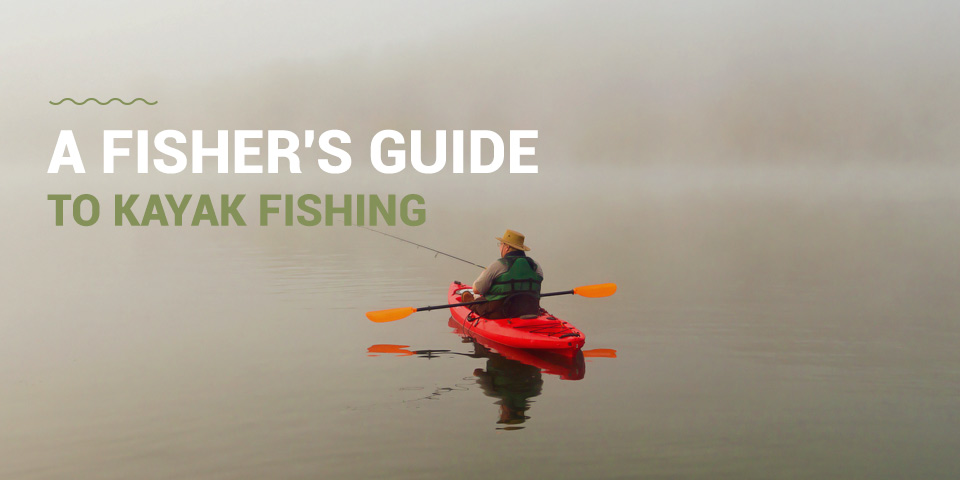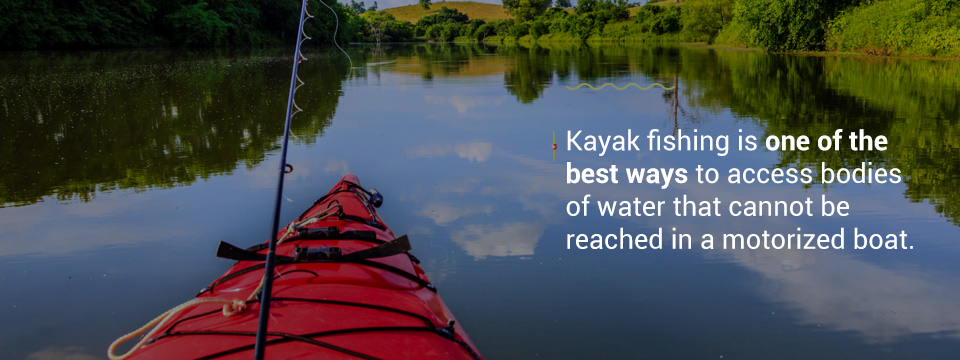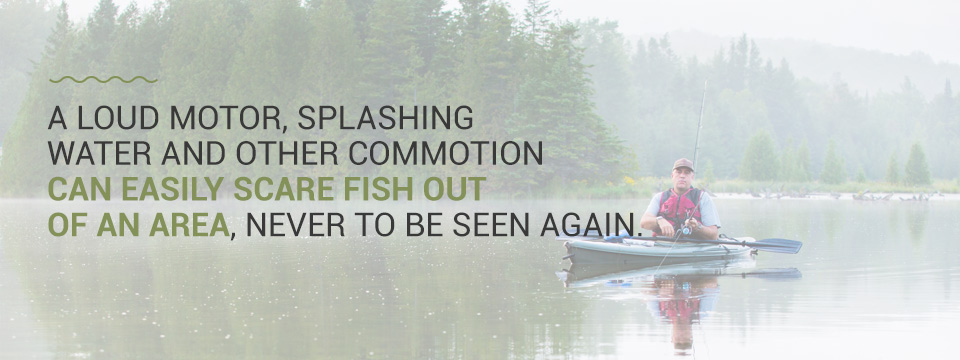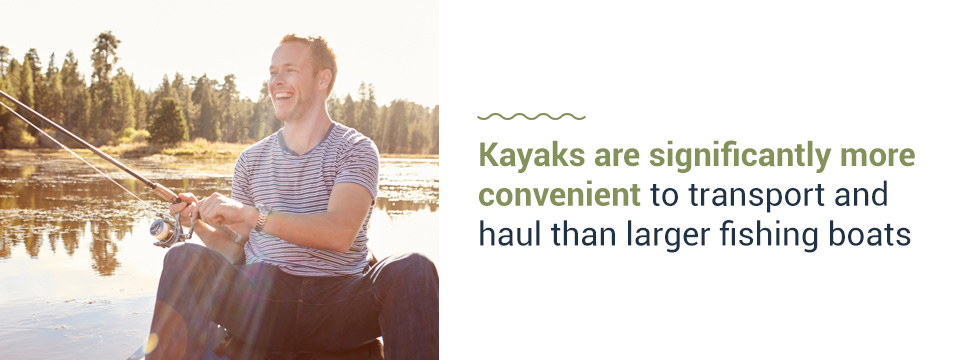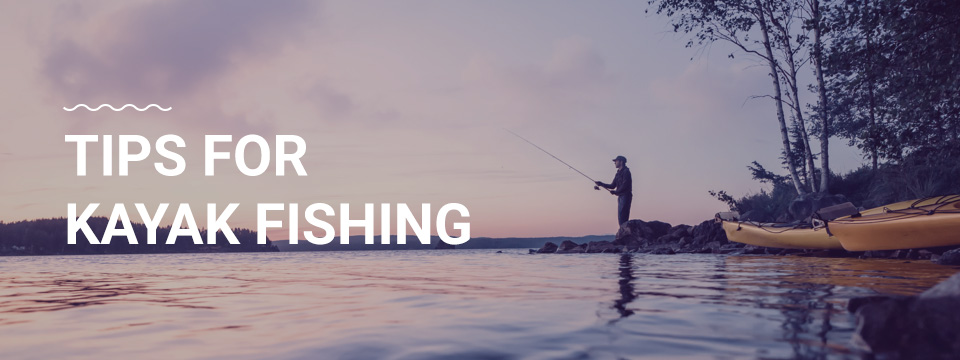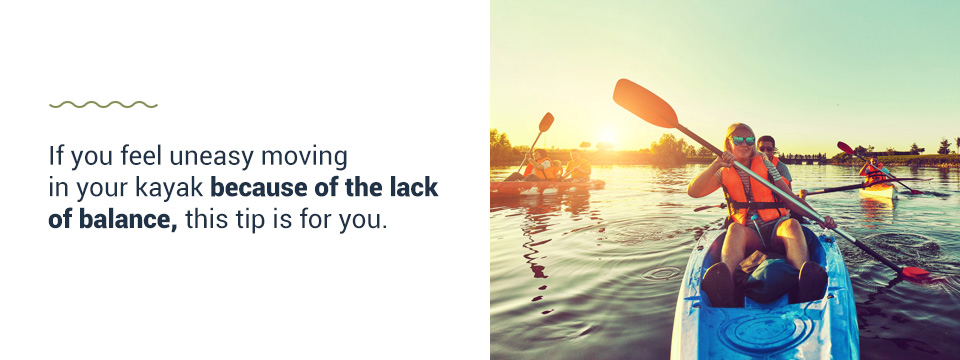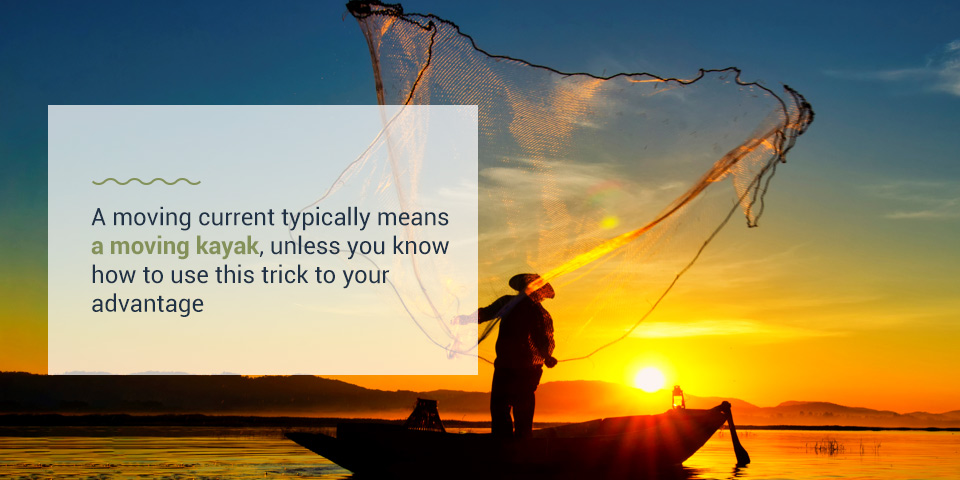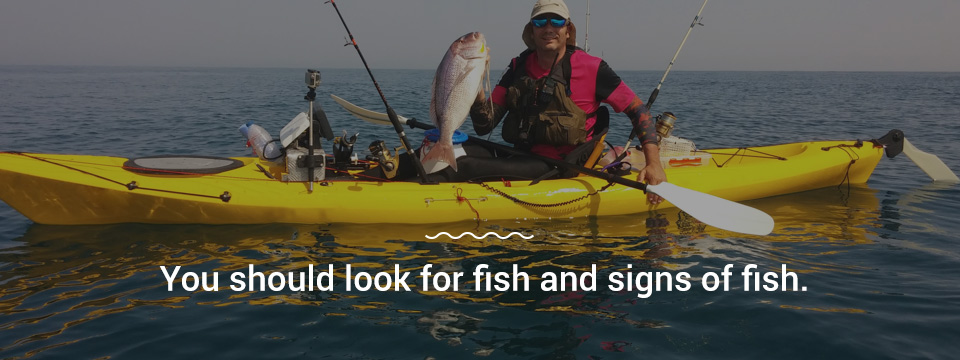Filters
A Fisher’s Guide to Kayak Fishing
From deep-sea fishing to fly fishing in a wooded creek, over 54 million people went fishing at least once in 2020. Fishing is such a popular sport and pastime because there are many ways to do it and new methods to challenge yourself as an angler. One variation of fishing that has recently gained popularity is kayak fishing. If you’re looking for a new way to get out on the water, test your skills or learn new ones, kayak fishing could be for you.
Table of Contents
What Is Kayak Fishing?
Kayak fishing is simply fishing from a kayak instead of on a larger fishing boat or from the shore. Using non-motorized boats for fishing, like kayaks or canoes, is a concept that has been around for centuries, though it’s most recently gained popularity among sport and recreational anglers. You can kayak fish in freshwater ponds, lakes and streams, or saltwater coastlines and inlets, especially in warmer climates or during warm weather. Anglers use kayaks to catch a variety of fish for competitions, food and fun.
When Is It Best to Fish on Kayaks?
Any time is the best time to go kayak fishing! As you’ll learn later in our guide, kayak fishing is one of the best ways to access bodies of water that cannot be reached in a motorized boat. If you want to find new places to fish, it’s best to fish in a kayak.
Benefits of Kayak Fishing
Numerous benefits of kayak fishing make the activity fun and appealing for new or experienced anglers. While far from being an extensive list, here are seven benefits that draw anglers to kayak fishing.
1. Water Accessibility
Fishing from a kayak gives you access to different bodies of water in a couple of ways. You can launch a kayak from anywhere you have access to a shoreline, unlike larger boats that require a boat launch. You can also access more remote fishing holes in bodies of water that may be too shallow or narrow for a large boat.
2. Economy and Environmental Friendliness
Kayaks are considerably more cost effective than a boat, even when completely decked out. Combining the purchase price, yearly maintenance and fuel costs, even smaller boats can put you out hundreds of thousands of dollars. Nice kayaks can range from a few hundred to a couple thousand dollars depending on the style and equipment you choose, making them a better option for your fishing budget. Additionally, kayaks are eco-friendly as they don’t burn fuel, helping you reduce your carbon footprint and preserve the environment.
3. Quietness and Stealth
All good anglers know how easily fish can be spooked. A loud motor, splashing water and other commotion can easily scare fish out of an area, never to be seen again. Luckily, kayaks allow anglers to move through the water with stealth so you can sneak up on fish and remain low-key as you fish a hole. While the fish remain unsuspecting, you also get to enjoy the peace and quiet while out on your kayak.
4. Low-Impact Exercise
Like most outdoor activities, kayak fishing is a good source of exercise and offers a few other health benefits. Carrying your kayak to and from your vehicle, paddling, casting your line and reeling in a fish all require energy and muscle strength and allow you to burn calories. Additionally, spending time outside helps lower blood pressure, provides healthy sun exposure and strengthens mental health.
5. New Fishing Angles
Sitting in or on a kayak allows you to be much closer to the water, giving you new fishing perspectives. Sitting lower makes throwing a cast under a dock or between fallen trees much easier. Flicking your bait into a tight space is much easier from a low vantage point. Plus, you’re closer to the action, making the experience that much more exciting when you get a bite.
6. Convenience
Kayaks are significantly more convenient to transport and haul than larger fishing boats. When equipped with roof racks, even small sedans can haul most types of kayaks. Kayaks can also be transported using a trailer or truck bed, though you’re not limited to using a trailer like you are with larger boats. Other options, like inflatable kayaks, can be folded up and put in your trunk or a backpack.
7. Customization and Accessories
Kayaks are fun and easy to customize and accessorize for fishing. Whether you have a fishing kayak or a recreational model you plan to fish out of, you can add many accessories and pieces of equipment to your kayak to make it your own and enhance your fishing experience. Deck out your kayak with lights and fishing technology, maximize your storage options or keep it as simple as possible — it’s completely up to you.
Equipment for Kayak Fishing
While you may think equipping a kayak for fishing would be challenging with limited space, it’s easier than you believe when you know what to take with you. Numerous types of equipment are necessary or helpful for kayak fishing. While you can successfully kayak fish with just a kayak, paddle and rod, here are some accessories that can make the experience better:
- Rod holders: Many kayaks come with built-in rod holders. If yours doesn’t, this tool is certainly something you’ll want to get. Rod holders can make your life much easier on the water, providing a place to store your rod while paddling or trolling or keeping extra rods out of the way.
- Personal flotation device (PFD): Many states require life jackets while you’re on the water, though it’s smart to have this equipment regardless of local regulations. Look for fishing-specific PFDs — they provide safety and often feature several pockets you can use to store tackle or pliers for quick usage.
- Anchor: An anchor can be extremely helpful, especially if you’re fishing in moving water like a river or stream or when the wind is pushing you out of a good spot. Just be sure to have something to tether it to on your kayak.
- Tackle crate: If you’re a dedicated angler, you likely have an extensive tackle box prepared for every situation. Instead of lugging your entire tackle box onto your kayak, pack a few of your favorite tackle, lures and baits in a crate you can store behind your seat. A tackle crate ensures you have what you need within reach without taking up valuable space.
- Paddle and rod leashes: Leashes keep your paddle and rods tethered to your kayak so there’s no chance of your paddle floating away or rods sinking if they fall into the water. Leashes and other flotation devices also help ensure you can retrieve all your gear if your kayak were to capsize.
- Fishfinder: If you enjoy using a fishfinder in a boat, put one in your kayak! Fishfinders are helpful for finding and staying on top of common fish in your area and viewing the layout of the ground beneath the water.
There are many other ways to accessorize and customize your kayak for fishing. The best part is you can keep changing your accessories as you learn what’s helpful to you and your fishing adventures.
Tips for Kayak Fishing
Whether you’re just starting with kayak fishing or are looking for help with sharpening your skills, we’ve got the right tips for you. Consider this advice for learning how to kayak fish and become a better kayak angler.
Choose the Right Kayak
While you can fish out of any kayak, some are designed with fishing in mind. They have a wider base, which provides more stability as you cast and reel and even allow you to stand up. Fishing kayaks also commonly have built-in rod holders and extra space for storing your gear and tackle.
Different kayak lengths are available, so you’ll want to consider where and how you’ll store and transport your model. Additionally, if you can, test the seat before you buy. Long days on the water can get cut short if you’re in an uncomfortable seat.
Take Your Kayak for a Test Drive
If you’ve never kayaked before or just got a new kayak, take it out on the water for a test drive before you start fishing. This allows you to get comfortable with how your kayak moves in the water and learn how to balance yourself while moving in various ways. Start slow and go out with just a rod to get a feel for the movements of casting and reeling. In a kayak, any movement will rock the boat, and you’ll have to keep yourself stable to fish comfortably.
Trust Your Kayak’s Stability
If you feel uneasy moving in your kayak because of the lack of balance, this tip is for you. While you’re getting comfortable with the movements and balance of your kayak in the water, we want to remind you to trust your kayak’s stability. While sudden movements will send you rocking, remember that your kayak was designed to rock to allow you to move with the water. Use this feature to your advantage as you cast, reel and figure out what works for you.
Start Somewhere Familiar
Once you’re really ready to take your kayak out fishing, start somewhere you’re familiar with or that you’ve fished in before. Choosing a familiar area gives you an idea of what to expect regarding the water conditions, types of fish and fishing conditions. When you know what you’re fishing for, it’s much easier to rig your rod for success. Starting in a familiar body of water can give you the confidence boost you need to find your groove.
Use the Water’s Terrain to Your Advantage
One of the best parts about kayak fishing is the ability to go where larger boats can’t. You can successfully maneuver along the shore, between trees, around stumps and through lily pads. Use this ability to your advantage to significantly increase your success on the water. Sit around partially submerged objects, explore changes in water depth and see what you can find in and around vegetation. You can go just about anywhere in your kayak, so do it!
Keep Your Fishing Gear Simple
When you’re starting, a crowded kayak can make tying on bait and handling fish challenging. You’ll find it’s very easy to drop things overboard. To help yourself juggle everything, keep your fishing gear simple while in your kayak. Limiting yourself to a couple of bait containers, lure boxes and one or two rods can give you enough room to work while still having the essentials onboard. As you get more comfortable and experienced, you might consider packing a milk crate of gear for your fishing trips.
Drop Your Kayak in Anywhere
As we mentioned earlier, one benefit of kayak fishing is the ability to put your kayak in almost any body of water because you don’t need a boat launch. This is absolutely something you should take advantage of. Put your kayak in the creek you pass every day on your way to work or the pond down the street from your house.
Try putting your kayak anywhere you normally have to fish from the shore. Using a kayak is one of the best ways to find some new honey holes.
Learn to Use One Hand
If you’re looking for ways to become a better angler, one of the best things you can do is learn to use one hand. As a kayak angler, it’s beneficial to be able to cast one-handed. Because you’re lower to the water, your typical two-handed cast will be a bit harder to accurately control or cast as far as you may like.
Using both hands could put you in some tricky situations requiring untangling. A one-handed side cast allows you to whip your bait or lure into tight spaces or further distances along the water’s surface.
Another one-handed skill that will make your kayak fishing trips much easier is paddling with one hand. This move will take some practice, though it will certainly pay off. If you have yet to experience a situation where you must try to maneuver your kayak with one hand, consider yourself lucky. For example, if your hook gets caught on a submerged branch or stuck in high weeds, you’ll likely have to paddle over to where it’s caught while simultaneously reeling in the slack.
To successfully maneuver your kayak in situations like this, anchor the shaft of your paddle on one arm and use your free hand to use the paddle like a canoe oar to move. The more time you spend on the water, the more situations you’ll learn to figure out. Find your own techniques that work well for you, and you’ll discover success.
Sit in Eddies
A moving current typically means a moving kayak, unless you know how to use this trick to your advantage. Eddies are spots where the current is moving in the opposite direction, causing a whirlpool-like calm area. Use an eddy to fish a stretch of stream or river. If your kayak is light enough and short enough, you can sit in an eddy to keep your kayak from floating downstream. This allows you to stop and fish the current without having to fight it to stay in one spot long enough to catch anything.
Use Your Baits to Steer Your Kayak
In some cases, you can use your baits to help steer and pull your kayak in a certain direction. If you’re fishing out of a lightweight kayak, spinnerbaits, crankbaits, chatterbaits and other baits that provide some resistance can subtly pull your kayak in the direction you cast. As you reel in these baits, their resistance against the water will turn or pull your kayak. You can use this ability to your advantage if you want to move your kayak slightly or turn to face a different direction.
Simply cast your bait in the direction you’re looking to move toward and reel it back in to nudge your kayak without putting your paddle in the water. This is a great way to sneak up on some fish without disturbing the water or causing a commotion.
Put Your Feet in the Water
If you’re kayak fishing somewhere warm, you likely already stick your feet in the water just to cool down when the sun gets too hot. If you’re already doing this, you’re one step ahead. In addition to getting some relief on hot days, you can use your feet to steer, drift or anchor your kayak.
You’ll be surprised how often this trick comes in handy. If you’re letting a current carry your kayak, you can stick your foot out and use it as a rudder to drift or steer in a certain direction.
To anchor yourself using your foot, simply stick your foot out and hold on to a stump, rock or other object in the water to keep from moving. Sometimes using your foot is much easier than throwing out your actual anchor. After you’re done fishing in the spot you anchored to, use your foot to push off the object you were holding on to so you can get back into the current or more open space.
Carry Multiple Pre-Rigged Rods
Sometimes what you throw at the fish just isn’t what they want to see. As frustrating as this can be, you can waste a lot of time retying lures and trying new baits and setups to find something that works. To save yourself time and the frustration of retying lure after lure, carry multiple pre-rigged rods. Choose a couple of baits or lures that you find yourself consistently selecting and put them each on their own rod.
This way, when one lure isn’t producing results, you can quickly switch it out with another rod and lure. If you spend a few minutes before your trip thoughtfully planning what lures to put on your rods, you can make more casts and increase your chances of catching more fish.
Master the Art of Sight Fishing
Sight fishing is another great skill to learn, especially if you’re fishing in clear waters or don’t have a fishfinder. Sight fishing involves finding the fish with your eyes and casting into that area. To really master this technique, you’ll want to get a pair of polarized sunglasses because they remove the glare from the water’s surface. If the water is clear enough, the glasses will allow you to see everything beneath the water.
If you have a kayak that can support you while standing, try doing so to see further ahead of and around your kayak. You should look for fish and signs of fish. For example, during the bass spawning season, sight fishing for bass beds is a great way to find promising areas to cast a lure.
Dock Your Kayak With EZ Dock
Having a place to safely store and launch your kayak can make your fishing trips easier and enable you to get on the water more often. An EZ Launch® kayak dock makes entering and exiting the water safe and easy for kayakers of all skill levels.
Connect the EZ Launch with any of our EZ Dock sections to make kayak launching and docking a quick and straightforward process. For more information and to find out how we can help with all your docking needs, contact EZ Dock today!

